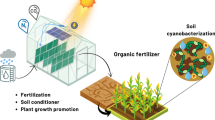Abstract
After 23 days without water in a greenhouse, rates of nocturnal CO2 uptake in Tillandsia schiedeana decreased substantially and maximum rates occurred later in the dark period eventually coinciding with the onset of illumination. Nocturnal CO2 uptake accounted for less than half the total nighttime increase in acidity measured in well-watered plants. With increased tissue desiccation, only 11–12% of measured acid accumulation was attributable to atmospheric CO2 uptake. Plants desiccated for 30 days regained initial levels of nocturnal acid accumulation and CO2 uptake after rehydration for 10h. These results stress the importance of CO2 recycling via CAM in this epiphytic bromeliad, especially during droughts.
Similar content being viewed by others
References
Barcikowski W and Nobel PS (1984) Water relations of cacti during desiccation: distribution of water in tissues. Bot Gaz 145:110–115
Bartholomew B (1973) Drought response in the gas exchange of Dudleya farinosa (Crassulaceae) grown under natural conditions. Photosynthetica 7:114–120
Benzing DH (1980) The biology of the bromeliads. Eureka: Mad River Press
Benzing DH and Dahle CE (1971) The vegetative morphology, habitat preference and water balance mechanisms of the bromeliad Tillandsia ionantha Planch. Amer Midl Nat 85:11–21
Benzing DH and Renfrow A (1971) The significance of photosynthetic efficiency to habitat preference and phylogeny among tillandsioid bromeliads. Bot Gaz 132:19–30
Biebl R (1964) Zum Wasserhaushalt von Tillandsia recurvata L. und Tillandsia usneoides L. auf Puerto Rico. Protoplasma 58:345–368
Coutinho LM (1963) Algumas informações sôbre a occorrência do “Efeito de De Saussure” em epífitas e erbáceas terrestres da mata pluvial. Botânica (Brazil) 20(288):83–98
Coutinho LM (1969) Novas observações sôbre a occorrência do “Efeito de De Saussure” e suas relações com a suculência, a temperatura folhear e os movimentos estomáticos. Botânica (Brazil) 24(331):79–102
Downs RJ (1974) Anatomy and physiology. In Smith LB and Downs RJ. Flora Neotropica, Monogr No 14 (Pitcairnioideae) (Bromeliaceae), pp. 2–28. New York: Hafner Press
Goh CJ, Wara-Aswapati O and Avadhani PN (1984) Crassulacean acid metabolism in young orchid leaves. New Phytol 96:519–526
Hanscom ZIII and Ting IP (1978) Responses of succulents to plant water stress. Plant Physiol 61:327–330
Hoagland DR and Arnon DI (1938) The water-culture method for growing plants without soil. Calif Agric Exp Sta Circ 347
Kluge M, Lange OL, vonEichmann M and Schmid R (1973) Diurnaler Säurerhythmus bei Tillandsia usneoides: Untersuchungen über den Weg des Kohlenstoffs sowie die Abhängigkeit des CO2-Gaswechsels von Lichtintensität, Temperatur und Wassergehalt der Pflanze. Planta 112:357–372
Kluge M and Ting IP (1978) Crassulacean acid metabolism. Analysis of an ecological adaptation. Berlin: Springer-Verlag
Martin CE (1980) Field and laboratory studies of Crassulacean acid metabolism in the epiphyte Tillandsia usneoides L. (Spanish moss). PhD dissertation, Duke University, Durham, NC
Martin CE, Christensen NL and Strain BR (1981) Seasonal patterns of growth, tissue acid fluctuations, and 14CO2 uptake in the Crassulacean acid metabolism epiphyte Tillandsia usneoides L. (Spanish Moss). Oecologia 49:322–328
Martin CE and Jackson JL (1986) Photosynthetic pathways in a midwestern rock outcrop succulent, Sedum nuttallianum Raf. (Crassulaceae). Photosyn Res 8:17–29
Martin CE and Peters EA (1984) Functional stomata of the atmospheric epiphyte Tillandsia usneoides L. Bot Gaz 145:502–507
Martin CE and Siedow JN (1981) Crassulacean acid metabolism in the epiphyte Tillandsia usneoides L. (Spanish moss). Responses of CO2 exchange to controlled environmental conditions. Plant Physiol 68:335–339
Martin CE and Zee AK (1983) C3 photosynthesis and Crassulacean acid metabolism in a Kansas rock outcrop succulent, Talinum calycinum Engelm. (Portulacaceae). Plant Physiol 73:718–723
Medina E (1974) Dark CO2 fixation, habitat preference and evolution within the Bromeliaceae. Evolution 28:677–686
Medina E, Delgado M, Troughton JH and Medina JD (1977) Physiological ecology of CO2 fixation in Bromeliaceae. Flora 166:137–152
Nobel PS (1976) Water relations and photosynthesis of a desert CAM plant, Agave deserti. Plant Physiol 58:576–582
Nobel PS (1977) Water relations and photosynthesis of a barrel cactus, Ferocactus acanthodes, in the Colorado Desert. Oecologia 27:117–133
Nobel PS and Hartsock TL (1983) Relationships between photosynthetically active radiation, nocturnal acid accumulation, and CO2 uptake for a Crassulacean acid metabolism plant, Opuntia ficus-indica. Plant Physiol 71:71–75
Osmond CB (1978) Crassulacean acid metabolism: a curiosity in context. Ann Rev Plant Physiol 29:379–414
Osmond CB, Nott DL and Firth PM (1979) Carbon assimilation patterns and growth of the introduced CAM plant Opuntia inermis in eastern Australia. Oecologia 40:331–350
Penfound WT and Deiler FG (1947) On the ecology of spanish moss. Ecology 28:455–458
Sinclair R (1983) Water relations of tropical epiphytes I. Relationships between stomatal resistance, relative water content and the components of water potential. J Exp Bot 34:1652–1663
Sinclair R (1983) Water relations of tropical epiphytes II. Performance during droughting. J Exp Bot 34:1664–1675
Sinclair R (1984) Water relations of tropical epiphytes III. Evidence for Crassulacean acid metabolism. J Exp Bot 35:1–7
Smith JAC (1984) Water relations in CAM plants. In Medina E, ed. Physiological ecology of CAM plants, pp. 30–51. Caracas: CIET (IVIC-UNESCO)
Smith JAC, Griffiths H, Bassett M and Griffiths NM (1985) Day-night changes in the leaf water relations of epiphytic bromeliads in the rain forests of Trinidad. Oecologia 67:475–485
Szarek SR, Johnson HB and Ting IP (1973) Drought adaptation in Opuntia basilaris. Significance of recycling carbon through Crassulacean acid metabolism. Plant Physiol 52:539–541
Szarek SR and Ting IP (1974) Seasonal patterns of acid metabolism and gas exchange in Opuntia basilaris. Plant Physiol 54:76–81
Ting IP (1985) Crassulacean acid metabolism. Ann Rev Plant Physiol 36:595–622
Author information
Authors and Affiliations
Additional information
Partially supported by Biomedical Sciences Support Grant RR07037.
Rights and permissions
About this article
Cite this article
Martin, C.E., Adams, W.W. Crassulacean acid metabolism, CO2-recycling, and tissue desiccation in the Mexican epiphyte Tillandsia schiedeana Steud (Bromeliaceae). Photosynth Res 11, 237–244 (1987). https://doi.org/10.1007/BF00055063
Received:
Revised:
Accepted:
Issue Date:
DOI: https://doi.org/10.1007/BF00055063




